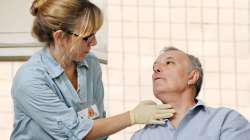New wearable device can help millions with swallowing problems
Scientists have developed a new wearable monitoring device that will make treatments easier and more affordable for millions of people with swallowing disorders.

Scientists have developed a new wearable monitoring device that will make treatments easier and more affordable for millions of people with swallowing disorders. The skin-mountable sensor sticker attaches firmly to the neck area and is connected with small cables to a wireless transmitter unit. The sensor sticker measures and records muscle activity and movement associated with swallowing.
The information is then sent wirelessly by a separate unit clipped on the wearer's shirt to software that stores it for later analysis by a doctor.
Successful completion of a swallow requires the precise coordination of more than 30 pairs of muscles of the head and neck, six pairs of cranial nerves, and complex circuitry in the brainstem and several brain areas.
Any disruption in these pathways can result in severe swallowing disorders.
"We want to provide a reliable, patient-friendly and affordable way to treat the millions of people with swallowing disorders," said Georgia A Malandraki, an associate professor of speech, language, and hearing sciences in Purdue University.
"Many devices to help these people are expensive, not able to be taken home and not accessible in many rural areas".
The sensor stickers are disposable, designed with inexpensive components and meant to be used about 10 times before they are thrown away, said the study published in the journal Science Advances.
"The sensor sticker is stretchable and flexible to work well with the skin and curvilinear head and neck shape, while the connected unit has electronic chips and more rigid components," said Chi Hwan Lee, assistant professor of biomedical engineering and mechanical engineering in Purdue's College of Engineering.
"Our device is unique in that we specifically created it to work well with the small and intricate muscles associated with swallowing events," he added.
Inputs from IANS.